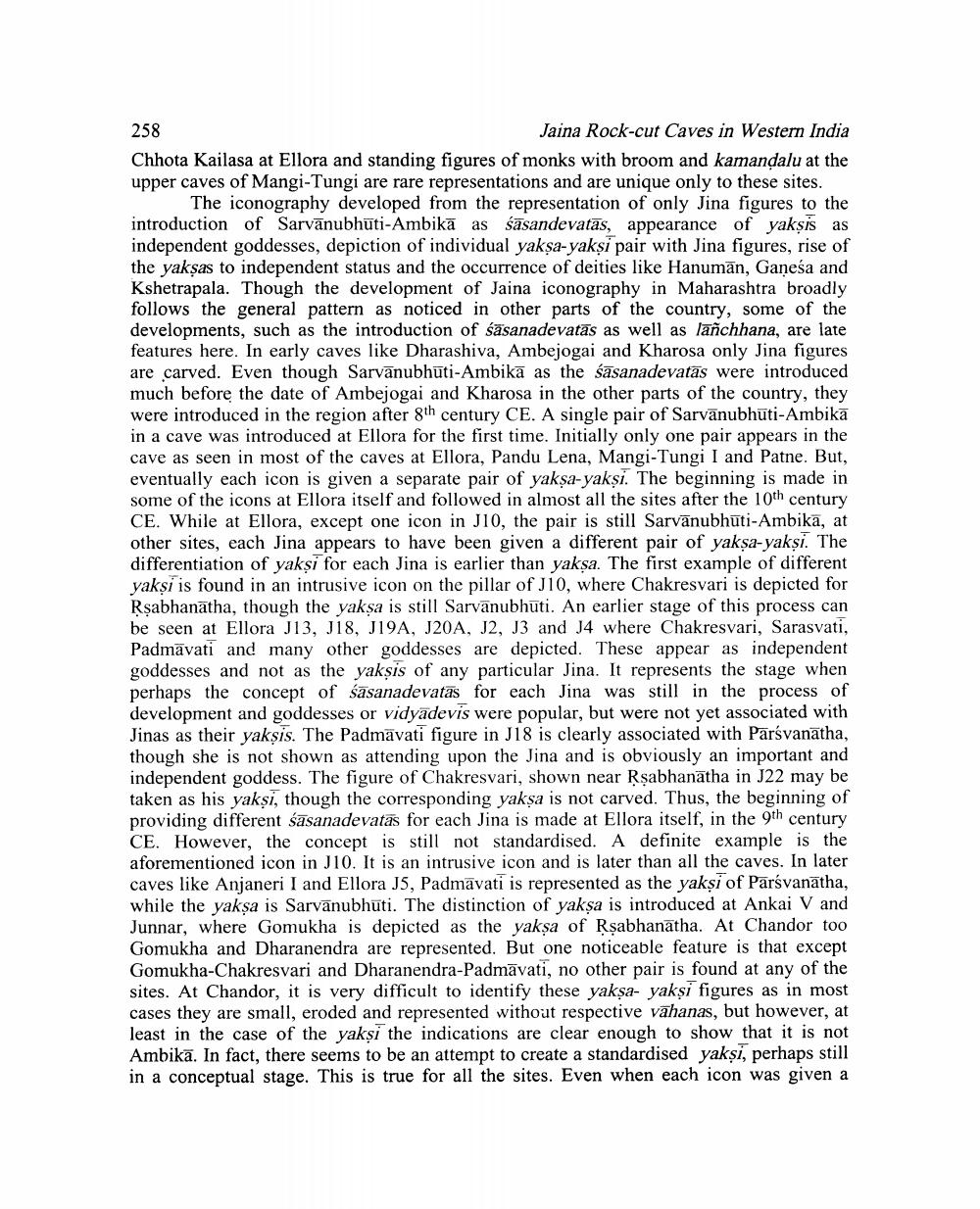________________
258
Jaina Rock-cut Caves in Western India Chhota Kailasa at Ellora and standing figures of monks with broom and kamandalu at the upper caves of Mangi-Tungi are rare representations and are unique only to these sites.
The iconography developed from the representation of only Jina figures to the introduction of Sarvānubhūti-Ambikā as śāsandevatās, appearance of yaksis as independent goddesses, depiction of individual yakşa-yaksi pair with Jina figures, rise of the yakşas to independent status and the occurrence of deities like Hanumān, Ganesa and Kshetrapala. Though the development of Jaina iconography in Maharashtra broadly follows the general pattern as noticed in other parts of the country, some of the developments, such as the introduction of sasanadevatas as well as lañchhana, are late features here. In early caves like Dharashiva, Ambejogai and Kharosa only Jina figures are carved. Even though Sarvānubhuti-Ambikā as the sasanadevatas were introduced much before the date of Ambejogai and Kharosa in the other parts of the country, they were introduced in the region after 8th century CE. A single pair of Sarvanubhuti-Ambika in a cave was introduced at Ellora for the first time. Initially only one pair appears in the cave as seen in most of the caves at Ellora, Pandu Lena, Mangi-Tungi I and Patne. But, eventually each icon is given a separate pair of yakşa-yaksi. The beginning is made in some of the icons at Ellora itself and followed in almost all the sites after the 10th century CE. While at Ellora, except one icon in J10, the pair is still Sarvānubhūti-Ambika, at other sites, each Jina appears to have been given a different pair of yakşa-yaksi. The differentiation of yaksi for each Jina is earlier than yaksa. The first example of different yakşi is found in an intrusive icon on the pillar of J10, where Chakresvari is depicted for Rsabhanatha, though the yaksa is still Sarvänubhuti. An earlier stage of this process can be seen at Ellora J13, J18, J19A, J20A, J2, J3 and 14 where Chakresvari, Sarasvati, Padmāvati and many other goddesses are depicted. These appear as independent goddesses and not as the yaksis of any particular Jina. It represents the stage when perhaps the concept of sasanadevatās for each Jina was still in the process of development and goddesses or vidyadevis were popular, but were not yet associated with Jinas as their yaksis. The Padmavati figure in J18 is clearly associated with Parsvanatha, though she is not shown as attending upon the Jina and is obviously an important and independent goddess. The figure of Chakresvari, shown near Rşabhanatha in J22 may be taken as his yakşi, though the corresponding yaksa is not carved. Thus, the beginning of providing different sāsanadevatas for each Jina is made at Ellora itself, in the 9th century CE. However, the concept is still not standardised. A definite example is the aforementioned icon in J10. It is an intrusive icon and is later than all the caves. In later caves like Anjaneri I and Ellora J5, Padmavati is represented as the yakși of Parsvanatha, while the yaksa is Sarvānubhuti. The distinction of yaksa is introduced at Ankai V and Junnar, where Gomukha is depicted as the yakşa of Rşabhanatha. At Chandor too Gomukha and Dharanendra are represented. But one noticeable feature is that except Gomukha-Chakresvari and Dharanendra-Padmāvati, no other pair is found at any of the sites. At Chandor, it is very difficult to identify these yaksa- yaksi figures as in most cases they are small, eroded and represented without respective vahanas, but however, at least in the case of the yakşi the indications are clear enough to show that it is not Ambikā. In fact, there seems to be an attempt to create a standardised yaksi, perhaps still in a conceptual stage. This is true for all the sites. Even when each icon was given a




